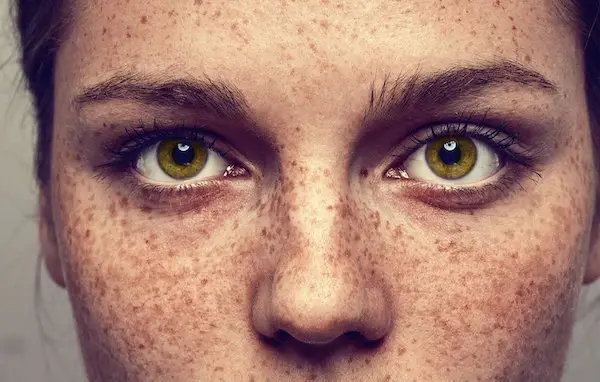Why are freckles called ephelides ?
FRECKLES :
Freckles clusters of concentrated melaninized cells which are most easily visible on people with a fair complexion. Freckles do not have an increased number of the melanin-producing cells, or malanocytes, but instead have melanocytes that overproduce melanin granules changing the coloration of the outer skin cells . As such, freckles are different from lentigines and moles which are caused by accumulation of melanocytes in a small area. Freckles can appear on all types of skin tones.
WHAT ARE THE CAUSES OF FRECKLES ?
Ephelides are an inherited characteristic. People with many ephelides have at least one copy of a variant MC1R gene, which is the same variant that causes red hair. Freckles in non-Caucasians are associated with a different variant of the gene.
The pigment -forming cells, melanocytes , produce more pigment than usual in ephelides. The pigment is packaged as melanosomes and distributed to surrounding keratinocytes .
Ephelides increase in number following exposure to ultraviolet radiation [UV ] in sunlight .
The harmful rays of the sun can make your freckles darker and easier to see. This is more likely if you have light skin.
Too much sun may also cause your skin to become:
- Tanned
- Sunburned
- Blotchy
WHAT ARE THE CLINICAL FEATURES OF FRECKLES ?
Ephelides are found on sun-exposed sites, particularly the nose and cheeks.
- They are prominent during summer and fade during winter.
- Light to dark brown flat macules
- 3–10 mm in diameter
- Poorly defined and may merge into large patches
- Any shape; often round
Ephelides (freckles):
- Are genetic
- First show up when you’re around 2-3 years old, often after you’ve been in the sun
- Are usually on your arms, chest, face, and neck
- Can be red, dark brown, or light brown
- Can go away as you age
- May fade during the winter
- Are usually about 1-2 millimeters or bigger
- Have irregular borders that aren’t very defined
Solar lentigines:
- Are sometimes called age spots, sunspots, or liver spots
- Show up as you get older and are common if you’re 50 or older
- Can be anywhere on your body that gets sun, including areas like your back, chest, face, forearms, hands, and shins
- Don’t fade or disappear
- Can range from light yellow to dark brown in color
- Show up because of sun exposure and aging
- Have clear borders
Natural freckles don't need treatment. They aren’t a sign of a skin problem . As you get older, they may get lighter on their own or go away entirely, depending on what type of freckle they are.
If you don't like how your freckles look, treatments can help fade them. These include:- Chemicals like alpha hydroxy acid (AHA) and trichloroacetic acid (TCA)
- Laser treatments
- Cryotherapy (skin freezing)
- Chemical peels
- Creams like retinol, a form of vitamin A
A dermatologist will need to decide which treatment is best for you.
You should see a doctor if your freckles:
- Have jagged borders
- Aren’t symmetrical
- Are sore
- Have a diameter of more than 6 millimeters (about the size of a pencil eraser)
- Become raised off of your skin
- Have dark patches or multiple colors
- Start to grow or change size or color
You can avoid getting more freckles by protecting yourself from the sun. Some of the best ways are:
- Always wear a water-resistant sunscreen with broad-spectrum protection and an SPF of 30 or higher (even when it’s not sunny).
- Never use tanning beds.
- Don’t get sunburned.
- Always apply a broad-spectrum, water-resistant sunscreen, with a sun protection factor (SPF) of 30 or higher, to all exposed skin before going outside. Use sunscreen every day, even on cloudy days and in the winter. Reapply every two hours or sooner if you’re swimming or sweating.
- Wear a wide-brimmed hat, sunglasses with UV protection and lightweight long-sleeved shirts and pants while outside. Look for clothing with an ultraviolet protection factor label for extra protection.
- Avoid the peak UV hours, usually between 10:00 am and 4:00 pm.
- Avoid all forms of tanning. If you want a tanned look, try a spray-on tanning product.


Comments
Post a Comment